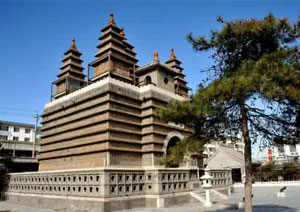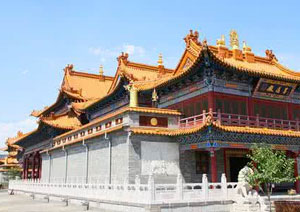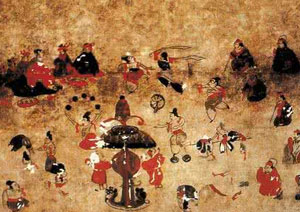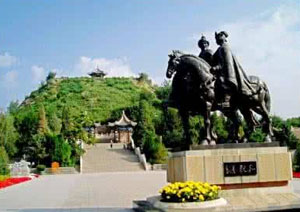It's worthwhile tracking down some of the famous Mongolian grasslands that lie within a hundred-kilometer radius of the city. These are Xilamuren (80km north of Hohhot), Gegentala (150km north) and Huitengxile (120km west). Most of the historic buildings of Hohhot are crowded into the interesting old southwestern part of the city. Chinese and Mongolian history mix in Hohhot, giving travelers a series of street-side surprises, from a fish skin robe exhibit to a one-time Mongolian neighborhood converted to entertainment halls and markets.
 Five Pagoda Temple, also called Jingangzuo Sheli Baota, seated in Wuta Jie, the southeastern part of the old town, and is a miniature temple built in Indian style. Originally the temple was used by followers and monks as a stuppa for relics and was, up until the Qing Dynasty (1644-1911 AD), a part of a larger complex, the Ci Deng Temple (Ci deng si). It is one of the only remaining parts of the original Ci Deng Temple compound located in the Old City of Hohhot. It stands amongst the ruins of old courtyard homes, which are being torn down to make way for new apartment buildings and a new way of life.
Five Pagoda Temple, also called Jingangzuo Sheli Baota, seated in Wuta Jie, the southeastern part of the old town, and is a miniature temple built in Indian style. Originally the temple was used by followers and monks as a stuppa for relics and was, up until the Qing Dynasty (1644-1911 AD), a part of a larger complex, the Ci Deng Temple (Ci deng si). It is one of the only remaining parts of the original Ci Deng Temple compound located in the Old City of Hohhot. It stands amongst the ruins of old courtyard homes, which are being torn down to make way for new apartment buildings and a new way of life.
 Alatan Khan, the chief of Tumd Tribe, began to believe in Buddhism when he was old. In accordance with his order, a lamasery was built in 1579 and given the name Dazhao Lamasery (Dazhao means "big" in Mongolian), which is located in the north of Dazhao Street of the old town. Dazhao Temple (Dazhao si) is the largest Gelukpa (Yellow Hat Sect) temple in town. It used to be a place where the feudal upper class enshrined and worshiped Buddha. It is a wooden building that is best preserved in Hohhot. Although built in 1579, during the Ming Dynasty(1368-1644 AD), the Temple was rebuilt in 1640, and today much of the temple retains the look from this period.
Alatan Khan, the chief of Tumd Tribe, began to believe in Buddhism when he was old. In accordance with his order, a lamasery was built in 1579 and given the name Dazhao Lamasery (Dazhao means "big" in Mongolian), which is located in the north of Dazhao Street of the old town. Dazhao Temple (Dazhao si) is the largest Gelukpa (Yellow Hat Sect) temple in town. It used to be a place where the feudal upper class enshrined and worshiped Buddha. It is a wooden building that is best preserved in Hohhot. Although built in 1579, during the Ming Dynasty(1368-1644 AD), the Temple was rebuilt in 1640, and today much of the temple retains the look from this period.
Fresco of Han Tomb in Helinger
 The fresco of Han tomb lies in the east of Xiaobanshen village about 40 kilometers southeast of Helinger County. Discovered in 1971, the tomb, which is mainly made out of bricks, consists of three graves. It was mainly made up of the way to the tomb, the three main sections of front, middle and back graves. The entrance of the tomb is towards east. The total length of the tomb is 19.85 meters. The 50 well-preserved frescos, which is delicately conceived and skilled drawn, vividly reflect the conditions of people, such as the agricultural and pasture productions in the later period of Donghan (25-20A.D.), entertainment activities, historical stories and so on.
The fresco of Han tomb lies in the east of Xiaobanshen village about 40 kilometers southeast of Helinger County. Discovered in 1971, the tomb, which is mainly made out of bricks, consists of three graves. It was mainly made up of the way to the tomb, the three main sections of front, middle and back graves. The entrance of the tomb is towards east. The total length of the tomb is 19.85 meters. The 50 well-preserved frescos, which is delicately conceived and skilled drawn, vividly reflect the conditions of people, such as the agricultural and pasture productions in the later period of Donghan (25-20A.D.), entertainment activities, historical stories and so on.
 The Zhaojun Tomb is said to be the resting place of Wang Zhaojun, the lady of honor of the Han Dynasty, from 51-53 BC, located on the southern bank of the Dahei River in the suburbs and about 8km to the south of Hohhot. It is now a key protected of the Inner Mongolia Autonomous Region. The story of Zhaojun's going beyond the Great Walls has since spread among the people. Zhaojun's tomb, a symbol of national unity, has become one of the eight historical scenic spots in Hohhot. In front of the tomb, are tablets with inscriptions and antique exhibition rooms. In the summer time, it is lush and green here. Hence, it is also crowned as "A Tomb Covered with Green".
The Zhaojun Tomb is said to be the resting place of Wang Zhaojun, the lady of honor of the Han Dynasty, from 51-53 BC, located on the southern bank of the Dahei River in the suburbs and about 8km to the south of Hohhot. It is now a key protected of the Inner Mongolia Autonomous Region. The story of Zhaojun's going beyond the Great Walls has since spread among the people. Zhaojun's tomb, a symbol of national unity, has become one of the eight historical scenic spots in Hohhot. In front of the tomb, are tablets with inscriptions and antique exhibition rooms. In the summer time, it is lush and green here. Hence, it is also crowned as "A Tomb Covered with Green".

